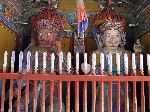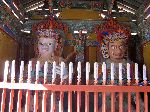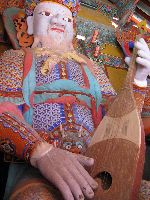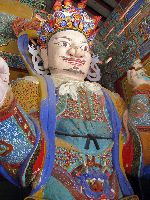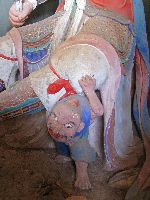Ibike Korea People-to-People Program
 Photo essay: Sangwonsa to Woljeongsa and Jeongseon
Photo essay: Sangwonsa to Woljeongsa and Jeongseon
Points of Interest Woljeongsa (temple) and museum, several small temples, cemetery of monks, folk village
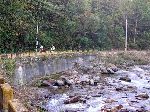
 Descending from Sangwonsa, we had a
final 9 km of dirt road, often near the river side. This section of dirt
was better maintained that the other side of the mountain. Appealing to
the heart strings, there were a couple of "squirrel crossings" (right) or
squirrel bridge. Besides a sign, there is a rope bridge suspended four
meters up, across the road.
Descending from Sangwonsa, we had a
final 9 km of dirt road, often near the river side. This section of dirt
was better maintained that the other side of the mountain. Appealing to
the heart strings, there were a couple of "squirrel crossings" (right) or
squirrel bridge. Besides a sign, there is a rope bridge suspended four
meters up, across the road. 
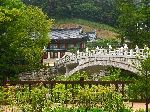
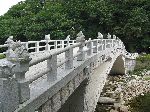 When
the road stops dropping so much you arrive at Woljeongsa (temple). You can
access it over an ornate bridge. The posts are capped by animals of the Korean
zodiac.
When
the road stops dropping so much you arrive at Woljeongsa (temple). You can
access it over an ornate bridge. The posts are capped by animals of the Korean
zodiac.
The Korean zodiac is derived from the Chinese zodiac. According to legend, the Jade Emperor invited the animals of his kingdom to enter a race through the countryside. The first 12 to finish the long race would each rule over one year every 12 years. The 12 animals are: rat, ox, tiger, rabbit, dragon, snake, horse, sheep, monkey, rooster, dog and pig. Each zodiac animal brings it own personality and characteristics to the year.
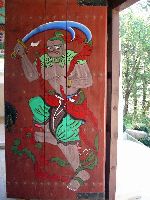
 To
enter the temple you must pass through colorful gates that welcome the faithful and are intended
to keep out the evil.
To
enter the temple you must pass through colorful gates that welcome the faithful and are intended
to keep out the evil.The Chenwangum (Woljeongsa) gate honors the four Devas. Though of Hindu origins, as devotees of Buddha, these figures guard Buddhist cannons and are the protective deities over monks and the faithful. The Jiguk Deva (lute) rules over the east, the Gwangmok Deva (dragon) over the west, the Jeungjang Deva (sword) over the south and the Damun Deva (pagoda) over the north. At the center of the four quarters is Sumisan. Sumisan is where Buddha lives -- a temple is symbolic of Sumisan, therefore, if one passes this gate he or she is likely to enter the world of Buddha.
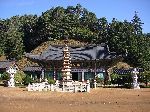
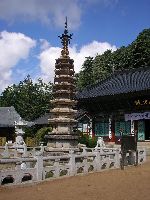
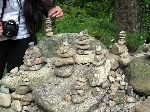
It is not uncommon to see a collection of do-it-yourself stacked-stone-pagoda around temples. There are are a number of explanation for the exercise; meditation, oneness in motion, each stone is a wish for good fortune for the builder or their family member or other relative, to feel compassion, etc.

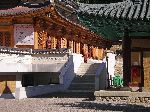

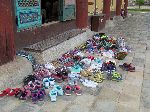 While the monks are in pray their
simple shoes are lined up outside the door. The shoes of other visitors have a
whole different look Among other differences, the slippers of the monks
are pointed away from the door and the shoes of the visitor remain as they were
left when the owners stepped out of them..
While the monks are in pray their
simple shoes are lined up outside the door. The shoes of other visitors have a
whole different look Among other differences, the slippers of the monks
are pointed away from the door and the shoes of the visitor remain as they were
left when the owners stepped out of them..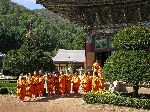
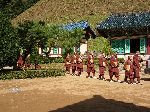 Female
monks (left) and male monks (right) emerge after prayers and return to the
housing area.
Female
monks (left) and male monks (right) emerge after prayers and return to the
housing area.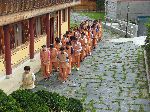
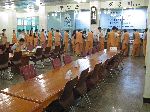 Woljeongsa
has a very active program for temple stays. Participants participate in
temple live including prayer, meditation, bows and meals.
Woljeongsa
has a very active program for temple stays. Participants participate in
temple live including prayer, meditation, bows and meals.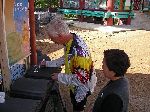
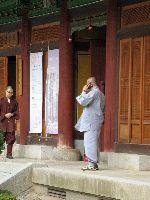 Jan
(left) dedicates a roof tile to the
bicycle group and ask Buddha's blessing during the journey. The tile will
become part of the temple restoration where it might remain for centuries.
Jan
(left) dedicates a roof tile to the
bicycle group and ask Buddha's blessing during the journey. The tile will
become part of the temple restoration where it might remain for centuries.For some reason it is intriguing to see monks using technology. This monk (right) is using a cell phone.


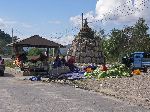 Fresh produce
is being harvested and sold on the road side near Jinbu. These photos show carrots,
onions, cabbages and assorted other local crops.
Fresh produce
is being harvested and sold on the road side near Jinbu. These photos show carrots,
onions, cabbages and assorted other local crops. 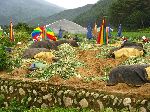
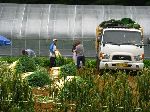 For
a good distance before we arrived at this farm it was clear what was being
harvested -- onion. A large work crew was working at several points on the
farm harvesting, bundling and loading trucks with onions.
For
a good distance before we arrived at this farm it was clear what was being
harvested -- onion. A large work crew was working at several points on the
farm harvesting, bundling and loading trucks with onions.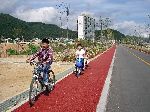
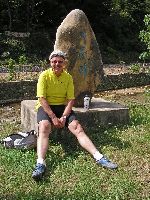
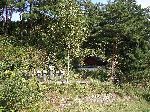

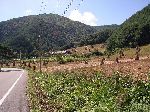
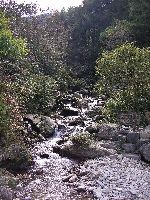

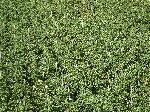
 On
the left is a field of red peppers. On the right are pepper drying.
On
the left is a field of red peppers. On the right are pepper drying.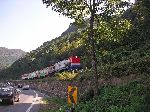
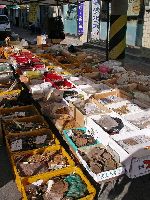
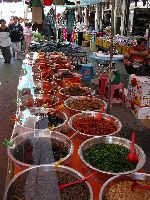 We
were lucky to arrive in
Jeongseon on the day of the five day market.
These photos show herbs and kimchi, but there were also fish, produce, cloths,
house wares, antiques, and a wide variety of there products available from the
vendors.
We
were lucky to arrive in
Jeongseon on the day of the five day market.
These photos show herbs and kimchi, but there were also fish, produce, cloths,
house wares, antiques, and a wide variety of there products available from the
vendors.
 One of the attractions in Jeongseon is Arari Village, a exhibits and
demonstrations of a rural village, houses and ways-of-life, in the Joseon
Dynasty period. The traditional
houses differed mostly in there choice of roofing material (oak bark
(upper left), slate rock, tile (right) and thatch (middle left)). A home
owners choice of roofing material seemed to be largely dependent upon
their economic position. The wealthy would choose
One of the attractions in Jeongseon is Arari Village, a exhibits and
demonstrations of a rural village, houses and ways-of-life, in the Joseon
Dynasty period. The traditional
houses differed mostly in there choice of roofing material (oak bark
(upper left), slate rock, tile (right) and thatch (middle left)). A home
owners choice of roofing material seemed to be largely dependent upon
their economic position. The wealthy would choose slate and tile.
There is also some variation in wall materials, but seemingly less so, an
example being whole log construction (middle left). The rooms in the
house were equipped so you could see how a traditional bedroom, study and
kitchen looked (right). Other exhibits showed tradition shops and crafts.
And there is a working water wheel (lower left) set up to pound grain. While
there weren't any other obviously foreign visitors during our
slate and tile.
There is also some variation in wall materials, but seemingly less so, an
example being whole log construction (middle left). The rooms in the
house were equipped so you could see how a traditional bedroom, study and
kitchen looked (right). Other exhibits showed tradition shops and crafts.
And there is a working water wheel (lower left) set up to pound grain. While
there weren't any other obviously foreign visitors during our visit, there
were plenty of Koreans enjoying the sunny afternoon and displays, and make
photo-memories of their visit (below).
visit, there
were plenty of Koreans enjoying the sunny afternoon and displays, and make
photo-memories of their visit (below).
 Please
contact us if you would like to be added to
Ibike's mailing list or have questions, comments, corrections or criticism. (Also, please let us know how you learned about us and
found this site.) Privacy policy.
Please
contact us if you would like to be added to
Ibike's mailing list or have questions, comments, corrections or criticism. (Also, please let us know how you learned about us and
found this site.) Privacy policy.
![]() IBF Homepage
IBF Homepage ![]() Ibike Programs
Ibike Programs
![]() Ibike Schedule
Ibike Schedule
![]() Search
Search
